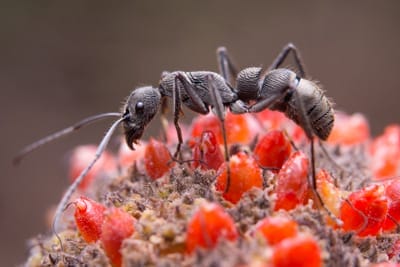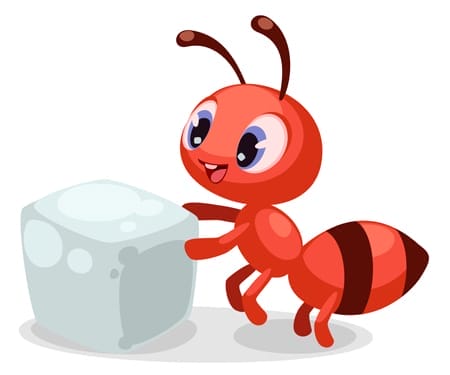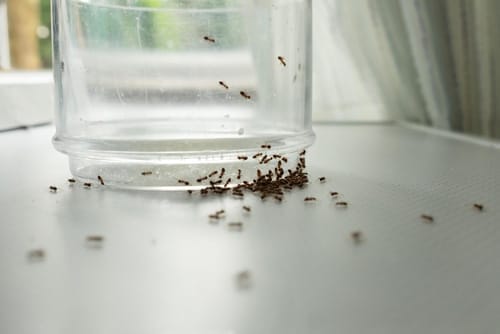What Kills Ants? Your Ultimate Guide to Ant-Free Living

We’ll dive into natural remedies like vinegar mixtures that keep your home safe and smelling fresh while battling these pesky invaders. But if things get out of hand, we’ll talk about when it’s time to call in the pros for backup.
From DIY tips to high-tech solutions, we’ve got all bases covered so you can reclaim your home from these tiny intruders once and for all.
Identifying the Enemy: Different Types of Ants in Your Home
When ants invade, they don’t come with a white flag or terms for negotiation. They march into your home like tiny conquerors claiming every crumb and crevice. But to effectively combat these six-legged intruders, you’ve got to know who you’re up against.
Carpenter Ants vs. Sugar Ants: Spot the Difference
Imagine this: Carpenter ants are the bulldozers of the ant world—they burrow through wood, creating galleries fit for their queen. Meanwhile, sugar ants might as well be carrying tiny baskets for all the sweets they scavenge around your kitchen. Telling them apart is crucial because while sugar ants pose no structural threat to your home, carpenter ants can wreak havoc on wooden elements.
To distinguish between these two common foes without calling Sherlock Holmes involves noting their size and appetite—carpenters are usually larger and have a fondness for wood whereas sugar ants are smaller with a sweet tooth that rivals any dessert lover’s dream.
The Lifecycle of an Ant Colony
If you understand how an ant colony works then you’re one step closer to sending those pests packing from whence they came. An ant colony operates under a monarchy—the queen calls the shots while workers run daily errands and soldiers defend territory.
Killing just a few worker ants won’t solve your problem; it’s about getting to Her Majesty herself since she’s responsible for repopulating her loyal subjects by thousands annually—and thus keeping an eye out on her lineage could help target treatments more effectively.
No matter what type has infiltrated your domain—be it odorous house ant guests or menacing carpenters—you need tactics tailored specifically towards each species’ weak points if victory is ever going to grace your doorstep again.
Natural Ant Killers: DIY Solutions for a Safer Home
Ants in your home can feel like uninvited guests that never leave. Instead of reaching for harsh chemicals, let’s explore some natural solutions to show these tiny trespassers the door.
Vinegar Mixtures: A Potent Ant Repellent
Mixing vinegar with water is an age-old trick that disrupts ants’ scent trails and keeps them from marching into your space. Just mix equal parts white vinegar and water in a spray bottle, give it a good shake, and spritz away on surfaces where you’ve seen ants roam. It won’t kill them on contact but works wonders as a deterrent.
The strong smell might be off-putting at first but disappears quickly as it dries—leaving behind nothing but ant-free counters and floors.
Essential Oils as Ant Deterrents
A dash of peppermint or tea tree oil isn’t just great for aromatherapy—it sends ants packing too. These oils mask their trail-following pheromones effectively enough to confuse any six-legged invaders trying to set up camp in your pantry or living room corners.
To whip up this repellent, add about 10 drops of essential oil per one cup of water in a spray bottle. Spritz along baseboards, windowsills, or wherever those critters congregate—their aversion to the potent scent will have them seeking real estate elsewhere fast.
In our pursuit of reclaiming our homes from unwelcome insects without compromising health standards, the Environmental Protection Agency suggests using low-risk pesticides, which includes ingredients found right in our kitchen cabinets or bathroom shelves. Embracing such strategies not only shields us from toxic substances; they’re also kinder to Mother Earth—and who wouldn’t want that?
Fact: Do you know the most common spiders often reside around ants inside homes?
Commercial Products vs. DIY Remedies: What Works Best?
Sometimes the line between an ant problem and a full-blown invasion is thin, so knowing whether to reach for commercial products or whip up a homemade concoction is key. It’s like deciding between calling in the cavalry or sticking with your trusty slingshot.
The Pros and Cons of Store-Bought Ant Baits
When you pick off-the-shelf baits, you’re grabbing scientifically-backed firepower designed to lure ants to their demise. These are not just deadly dinners but also clever double agents that let worker ants carry poison back to headquarters, wiping out colonies at the source.
But here’s the rub—store-bought solutions often come with labels warning of toxic ingredients that could harm pets or kids if they stumble upon them. They can hit your wallet harder than expected too; especially when those pesky ants decide it’s more fun playing hide-and-seek rather than taking the bait.
If we talk numbers, there’s evidence aplenty showing these manufactured marvels can effectively send ants packing from your home sweet home (EPA guidance on safe pest control). Still, effectiveness varies based on how well you play chess with these tiny six-legged opponents and if they choose to take what you lay down as a challenge.
Vinegar Mixtures: A Potent Ant Repellent
Moving over to DIY territory, vinegar isn’t just for salads anymore—it doubles as an ant repellent ninja. Mixing this pungent pantry staple with water creates a scent trail disruptor that leaves ants dazed and confused about where they’re heading.
The downside? You’ll need consistency in application because unlike store-baits’ lingering effects; vinegar’s repelling powers fade faster than fashion trends. And while it won’t directly kill the colony hiding behind walls, it sure will make them think twice about crossing into your domain again.
In essence, choosing between store-bought poisons and DIY methods boils down to assessing immediate needs against long-term safety considerations—and maybe how adventurous you’re feeling today. To add to your knowledge, read our piece on how to get rid of ants.
Tailored Strategies for Specific Ant Scenarios
Imagine you’re the general of an army, and your mission is to defend your home territory—the kitchen counter—from invaders. In this case, we’re talking about ants. Different types of invasions call for different battle plans.
When Baby Ants Invade: Starting Small
Baby ants in the house are like scouts testing your defenses. They signal that it’s time to act fast before their numbers grow. A simple yet effective tactic is a homemade bait—mixing borax with powdered sugar can lure them in and take out the tiny troopers quickly.
If they’ve made camp in hard-to-reach spots, consider diatomaceous earth. It’s a natural powder that works wonders by cutting through their exoskeletons without introducing toxins into your environment.
Battling Full-Scale House Infestations: Bring Out The Big Guns
A full-blown house ant infestation needs more than just spot treatments—it requires strategy and persistence. Start by securing food sources; make sure everything edible is sealed tight because if there’s nothing to eat, there’s no reason for them to stay.
Next up, lay down commercial gel baits or stations where ant traffic is heaviest; these not only kill on contact but also let worker ants bring poison back to the colony—a Trojan horse approach. But remember, while these methods might be effective immediately, maintaining cleanliness will keep those pesky pests from returning for a sequel attack.
No one said being general would be easy but armed with knowledge and tactics tailored for specific scenarios—you’re well-equipped to win this war against unwanted six-legged intruders.
Preventative Measures for Long-Term Ant Control
Say goodbye to uninvited six-legged gatecrashers with some savvy preventative strategies. Keeping ants out of your home isn’t just about the now; it’s about setting up defenses that last longer than a celebrity marriage.
Carpenter Ants vs. Sugar Ants: Spot the Difference
Think like an ant detective—knowing whether you’re dealing with carpenters or sugar lovers matters. Carpenter ants crave wood, not for breakfast but for their cozy nests, which could mean trouble for your Archic Furniture pieces. Meanwhile, sugar ants are after your sweet spills and crumbs. Telltale signs include fine sawdust from carpenters or trails towards sweets from their sugary cousins.
To keep these pesky critters at bay, seal up entry points like cracks and crevices around windows and doors—a move as effective as a goalie in a penalty shootout.
The Lifecycle of an Ant Colony
Cracking down on an ant invasion requires intel on how they operate—it’s all about breaking the cycle before it spins out of control like a runaway carousel. Understanding that queens lay eggs continuously can feel overwhelming but fear not. Regular maintenance is key here; think less ‘once in a blue moon’ and more ‘like clockwork.’
Maintain clean surfaces to discourage scouts from inviting the colony over because nobody wants their kitchen turned into Grand Central Station for ants.
Vinegar Mixtures: A Potent Ant Repellent
A dash of vinegar might be great on fries, but did you know it’s kryptonite to ants? Whip up a concoction using equal parts water and vinegar then spray away on surfaces where those little invaders strut too confidently—it disrupts their scent trails better than spilled perfume in department stores.
Essential Oils as Ant Deterrents
Last but not least, essential oils aren’t just spa day favorites—they send ants packing faster than tourists at closing time. Peppermint oil dabbed near potential entry points works wonders; its refreshing scent is essentially an “access denied” sign for any wandering worker ant looking to set up shop under your roof.
When to Call the Professionals: Handling Severe Infestations
Ants are like uninvited guests that never know when to leave. Sometimes, despite your best efforts with DIY solutions and store-bought traps, these tiny invaders insist on overstaying their welcome. That’s when you might face a severe infestation—one where ant armies seem endless and home remedies just don’t cut it.
If you’re seeing trails of ants even after using baits or if they’ve claimed territory in multiple areas of your home, it could be time for reinforcements. A professional exterminator brings more than just stronger products; they bring a battle plan tailored for total annihilation.
A pro doesn’t just go after the workers—they target the queen and her throne room (the nest). Without taking out the source, your ant problem is bound to return with a vengeance. And let’s not forget about carpenter ants—these wood-destroying critters need swift action before structural damage becomes another headache.
Carpenter Ants vs Sugar Ants: Spot the Difference
Distinguishing between carpenter ants, which can harm your furniture investments from Archic Furniture by tunneling through wood, and sugar ants attracted to sweets is key in choosing an extermination strategy.
The Lifecycle of an Ant Colony
To really understand why sometimes pros are needed we have to look at how resilient an ant colony can be. Queens can live for years, continuously laying eggs and expanding their empire beneath our feet—or floors in this case.
Natural Remedies vs Professional Help
Sure, natural methods have their place—for instance, vinegar mixtures may repel some scouts—but when it comes down to persistent intruders who laugh in the face of citrus peels or cinnamon sticks…well…you get where I’m going here?
In summary—not “in summary”—if what used to be an occasional line of ants has turned into something reminiscent of a sci-fi invasion scene—it’s high time you call someone who knows exactly how much firepower is needed because sometimes only professional-grade will do.
Innovative Solutions in Ant Control Technology
Technology has reshaped our battle against the six-legged invaders in our homes—ants. The latest gadgets and gizmos aren’t just fancy; they’re game-changers, zapping ant problems with a level of precision we’ve only dreamed about.
Technological advances have led to innovative solutions for ant control.
Imagine setting up an invisible barrier that ants can’t cross but is totally safe for your toddlers and pets. That’s no sci-fi fantasy—it’s real, thanks to electromagnetic devices that disrupt ants’ navigation systems. And it doesn’t stop there. Scientists are working on biological controls too, leveraging natural ant predators in ways that don’t harm the environment or non-target species.
We’re not talking about sprays and traps from yesteryear anymore; this is smart tech at its finest. Picture tiny sensors detecting pheromones—the very chemicals ants use to communicate—and then sending out signals to confuse them right back into oblivion. This means you could potentially eliminate an entire colony without ever seeing an ant body pile up.
The beauty of these advancements isn’t just their effectiveness but also their subtlety—you won’t even know they’re there until you realize your ant problem has vanished like last season’s fashion trends.
Tech-savvy homeowners can now find studies detailing how ultrasonic repellers might be more than just wishful thinking when it comes to turning away those pesky intruders without harsh chemicals cluttering your countertops or endangering curious cats who think everything is a toy or snack.
This technological revolution may soon make traditional pesticides as outdated as dial-up internet—meaning healthier homes for us and less collateral damage for Mother Earth because let’s face it, annihilating ants shouldn’t mean harming habitats. Also want to get rid of rodents? Get a fully professional rodent removal treatment at Texas Beeline!
Common Mistakes in DIY Ant Extermination
So you’ve decided to go toe-to-antenna with the six-legged invaders in your home. You’re armed with an internet’s worth of tips and tricks, but before charging into battle, let’s make sure you don’t fall into some all-too-common traps.
Carpenter Ants vs. Sugar Ants: Spot the Difference
Sometimes we think one ant killer fits all, but that’s like using a sledgehammer to swat a fly. Carpenter ants need different tactics than sugar ants. Carpenter ants aren’t there for your sweets; they want your wood. So if you see them, it might be time for damage control—literally. On the flip side, sugar ants are looking for crumbs from last night’s dessert marathon.
The first step is correctly identifying these critters because what kills carpenter ants won’t always send sugar ants packing—and vice versa. It helps to understand their cravings and habits since this will dictate which DIY method or product will send them marching out of your kitchen and back outside where they belong.
The Lifecycle of an Ant Colony
You might not care about ant sociology 101 when they’re parading across your counter, but hear me out—a little knowledge on the lifecycle of an ant colony can save you lots of trouble down the road. If you’re targeting scouts instead of taking down the queen who’s popping out babies faster than streaming service spin-offs, then friend—you’re just bailing water from a sinking ship.
To really get ahead in this war on antennae-equipped intruders? Target those reproductive powerhouses—the queens—and do so efficiently by understanding how colonies thrive and multiply.
The Environmental Impact of Ant Control
Going to war with ants in your home can sometimes feel like a battle without end. But as we deploy our arsenal of ant-killing tactics, it’s vital to consider the broader effects these methods may have on the environment. Traditional pesticides are often a go-to solution, but they carry heavy consequences for our ecosystems.
Carpenter Ants vs. Sugar Ants: Spot the Difference
Distinguishing between carpenter and sugar ants is more than an exercise in entomology; it informs which environmentally friendly strategies we might employ. Carpenter ants cause structural damage by tunneling through wood, so control methods often focus on preventing their wood-damaging escapades rather than using broad-spectrum insecticides that disrupt local habitats.
Sugar ants, attracted to sweet substances in your kitchen, pose less of a threat to your home’s integrity but can be just as persistent. By identifying them correctly, you’re one step closer to choosing targeted treatments that minimize ecological disruption—like opting for natural repellents over chemicals that could seep into waterways and soil.
The Lifecycle of an Ant Colony
To get ahead in this game against nature’s tiny soldiers without harming Mother Earth requires understanding their life cycle. Knowing when queens lay eggs or when colonies are most active lets us time interventions effectively while reducing unnecessary exposure of wildlife and plants to toxic substances found in some commercial ant killers.
By disrupting the colony at critical growth stages with low-impact practices such as boiling water pour-overs or diatomaceous earth applications—which both degrade quickly and harmlessly—we protect surrounding ecosystems from collateral damage usually wrought by conventional poisons used haphazardly.
We’ve all heard tales about how small actions lead up big changes; nowhere is this truer than within the world of pest management where thoughtful approaches not only solve immediate issues but also preserve environmental harmony for future generations—a win-win if ever there was one.
Conclusion
So you’ve explored what kills ants, learning that your approach must vary depending on the ant type. Keep in mind, carpenter and sugar ants aren’t just different in taste; they require distinct strategies to tackle.
Natural remedies? They’re a go-to for safety and simplicity. Remember vinegar mixtures and essential oils can be mighty allies against these critters. But when DIY doesn’t cut it, don’t hesitate to compare with commercial products or call the pros for severe cases—there’s no shame in needing an extra hand.
Tech advancements have also thrown some new weapons into the mix, proving innovation is key. Yet, never forget: prevention beats cure every time. To wrap up this battle plan: stay vigilant, act fast, and always aim for long-term peace over quick fixes. Now armed with knowledge and tactics—you’re set to reclaim your home!



